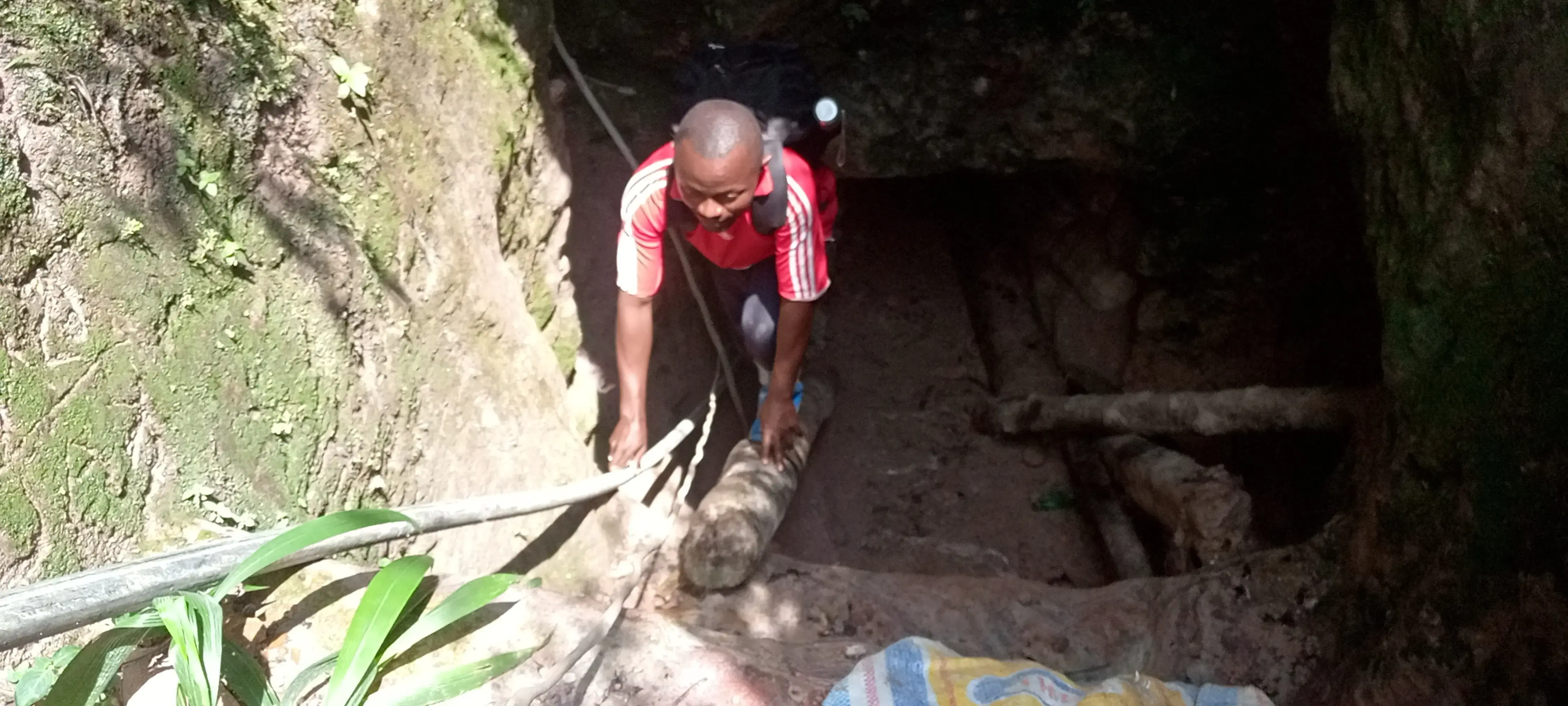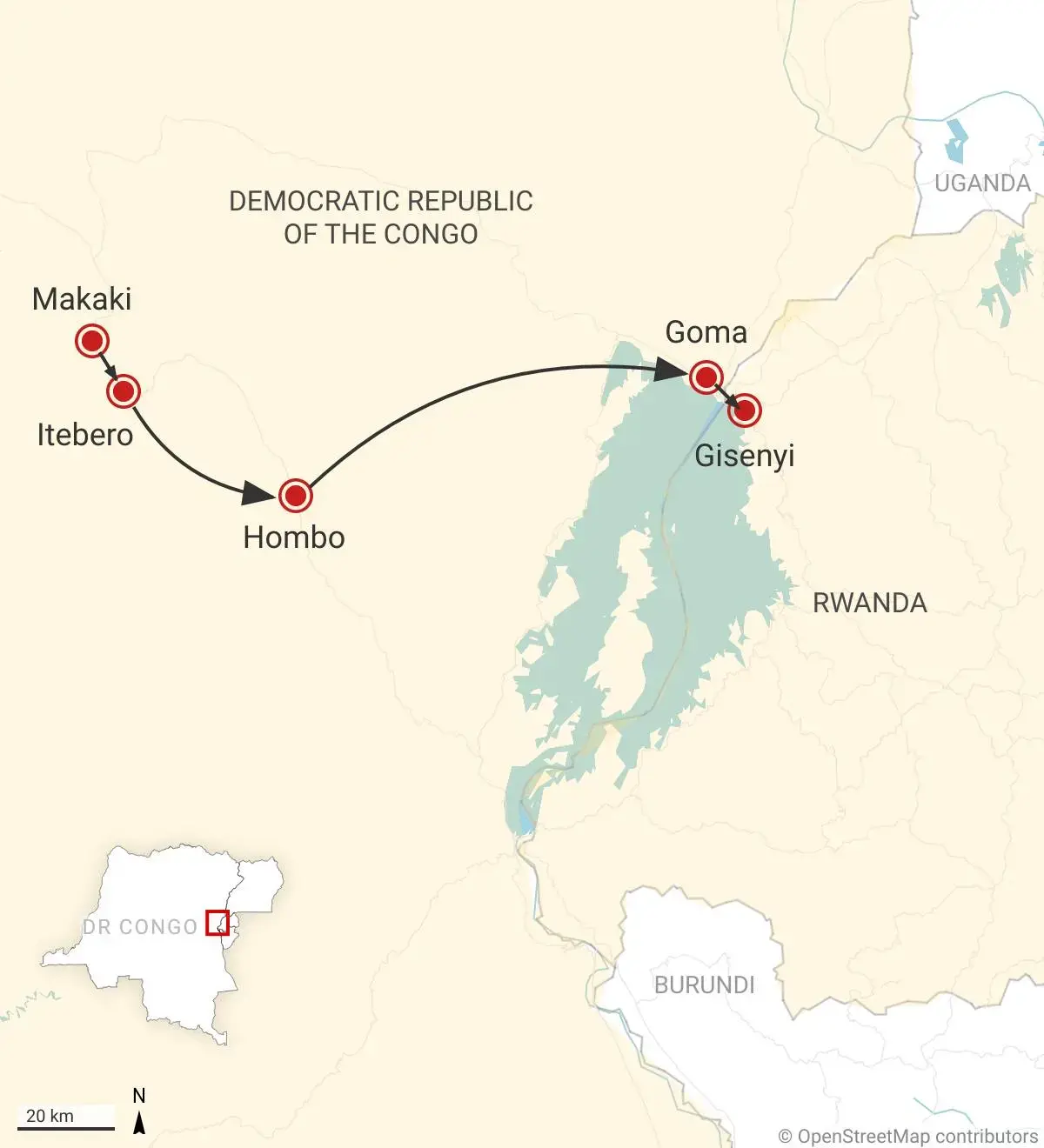
This story was translated from French. To read the original story, visit Greenafia, La Voix de l'UCG, or Actualite.cd.
Several studies by Western firms attempt to show that mining is not the main source of armed conflict in Kivu, but it is not the least important either. It is moreover the nerve of these armed conflicts, because it provides the necessary means to maintain them. And that is not from today. This report is part of a series of investigations that aim to discover the supply chain of illegal minerals from Kivu with interference from local and foreign armed groups around the Protected Areas. It is a report by Mukulu Vulotwa Hervé with the contribution of Georges Kisando and Didi Bunakima, produced with the support of the Pulitzer Center's Rainforest Investigations Network.
"There is a known theory since the AFDL war which says that the war in the DRC, once started, is self-financing. What does it finance itself with? It is with minerals found on the ground," points out Professor Nissé Mughendi, expert in the geopolitics of the Great Lakes region and director of the Office-Center for Studies for Peace and Security (BCEPS).
The Kivu Security Barometer, a joint project of the Groupe d'Etudes sur le Congo (GEC) and Human Rights Watch (HRW), maps 134 armed groups in 4 eastern provinces of the DRC. The province of North Kivu has 45 and South Kivu 89, almost the majority of which are made up of local militias called Mai-Mai.

As a nonprofit journalism organization, we depend on your support to fund journalism covering underreported issues around the world. Donate any amount today to become a Pulitzer Center Champion and receive exclusive benefits!
In these two provinces, the MiMiKi map offers an interactive platform of 200 mining sites based on 2009 data. The French Embassy in the DRC, in a report on mining, lists 1100 gold sites in Kivu and several sites of 3T minerals and coltan while specifying that these are "conflict minerals" of which 60 to 80% of the tantalum is smuggled with Rwanda.
In a study dating from 2017, the Episcopal Commission for Natural Resources (CERN), a structure of the National Episcopal Conference of Congo (CENCO) belonging to the powerful Catholic Church, lists 111 artisanal gold mining sites in the two territories of Beni and Lubero, in the north of the province of North Kivu, of which 86.4% of the production is dedicated to clandestinity and escapes at the same time from the State and the populations of the Great North.
Military business
In a mining site, a reality is known: “Everyone operates in the name of the cooperative, but not on behalf of the cooperative. There are military authorities who have wells. When we operate, the proceeds go directly to these military authorities. But these soldiers never show up at the sites. They use civilians so that their minerals can be tagged and transported to trading centers. There are also other sites like Kamuchanga, where dredges are used. There are dredgers that belong to the military, but are managed by civilians,” coltan operators in Walikale told us.
The FARDC officers in this business aren't talked about aloud, as this digger testifies. "I myself have already worked in two different wells that belong to military authorities here. I have already conveyed minerals belonging to my boss to the trading center. So it's not a story that I was told, but I lived it. After selling the minerals to traders, you take the money, give it to the pit owner."
There are also sites like that of Makaki, a village in the territory of Walikale (North Kivu), where there are armed men who exploit and transport the minerals to Hombo, thanks to their collaboration with certain inhabitants here without passing through the traceability process. Because from Itebero to Hombo, there is just one checkpoint in front of the sector office. Unfortunately, they bypass this post, and the motorcycles wait for the minerals on the other side of the barrier to transport them to Hombo.

In the Ihana, Kisamba, Usala and Isobo areas, there are unqualified, unvalidated sites that are considered red zones since it is the men in uniform who exploit gold and other minerals. They exploit and we do not know where this ore goes, say those in charge.
In much of Utunda and Wasa, there is heavy Congolese military involvement. At the sites, they trade in basic necessities. "They exploit indirectly through illegal operators," says Master Obedi Kamala, who assures us: “At Matungu, an emblematic site, I have seen men in uniform who appropriate wells. In Umate, I also lamented it. There are certain officers who give equipment to the operators such as the crusher, then it is to these FARDC officers that the operators report."
According to the IPIS map, which lists 3,276 artisanal mining sites in eastern DRC, the zone of interference by loyalist armed forces is almost present around the mining sites in the province of North Kivu.
In addition to these, there are local militias, called Mai-Mai. Célestin Bamwisho Bwira Bivuya, Permanent Secretary of the Amani program in the provinces of South Kivu and Maniena from 2008 to 2010, explains that created with self-defence in mind, the local militias turned to the exploitation of minerals for reasons of survival.
“They need the means to survive. They thus exploit the mining resources in such a way that they can supply themselves with ammunition and catering. In addition, they are responsible for families,” explains Kule Thatha, a researcher in conflict dynamics around Protected Areas at the Catholic University of Graben (UCG) in Butembo.
“If you go to Lubero territory, you will find a long history of armed groups that have been exploiting ore in Bunyatenge since Sieur La Fontaine. An officer deployed to the region by the Congolese government. He was a FARDC officer, because he had to create militias in the region that would destabilize rebellions ... but once his mission was accomplished, he stayed in the region because he found gold mines which the FDLR exploited and which he, too, learned to exploit. It's the same for militia leaders like Kasiano, Kabido, etc.," explains Nissé Mughendi.
Monsignor Sébastien Muyengo, President of the Natural Resources Commission within CENCO, says that one day, he pleaded with the entourage of Joseph Kabila, then President of the DRC, to appoint a great soldier who became a warlord in his diocese of Uvira as a General in order to stabilize the region. An adviser to Kabila said: "Monsignor, even if we name this man General or Marshal, he will never leave there because he has mineral wells there," this Catholic Prelate confided.
Among the national armed groups, there are armed groups created in the Congo, but sponsored by foreigners for their interests, like the Rassemblement Congolais pour la Démocratie, DRC/Goma, the National Congress for the Defense of the People, CNDP or those who commanded the armed wing, such as Bosco Taganda and Kunda Batware, claimed to be Rwandan once they were defeated and took refuge in Rwanda.
Following the rebellions that brought Laurent Kabila to power, several groups were created with a view to defending themselves against foreign occupation. But with their expansion into mining areas, they discovered the delights of minerals and were diverted from their mission to retreat to gold mines.
"Coltan revenues were an important part of what allowed the (DRC/Goma) to make the first budget in the history of the movement and to pay some money to civil servants at the end of 2000," reports Pole Institute, a research center based in Goma (North Kivu).
In this plundering of natural resources, some militias are also in the pay of neighboring countries, in particular Rwanda, a country that does not have enough coltan in its subsoil, but which was the leading producer in 2014, according to figures made public by the Rwanda Development Board and relayed by PR Newswire.
And most (of the militias) are called “mai-mai." “They are there simply to protect fraud, scheming and looting of DRC resources. I give you the case of Nyatura in Masisi, a mining territory,” says Kule Thata. “Even a police officer, if he is not of their obedience, cannot do 48 hours of service. He will already be dead," he testifies. Because an agent who doesn't belong to them is a threat to their business.
The Nyatura control and secure the fraud that passes through Lake Kivu for the most part. The canoes between Goma and Bukavu are a major corridor for mineral fraud, assures Kule Thata. As if to confirm the allegations of Monsignor Sébastien and the researcher Kule Thata, on May 24, 2022, two elected officials from the Dee Masisi territory argued in full parliament in Kinshasa about their respective militias. In a television program on CW TV, Deputy Tim Pululu, elected from Kinshasa, said he was outraged to see that two elected officials are at the root of the deaths of citizens in their region.
"In full plenary during information motions, we were outraged. The deputy Ndayishimiye, elected from Masisi, took the floor to denounce that a Tutsi in the territory of Masisi recruited Tutsi militias to bother his Hutu brothers in the territory of Masisi. Emphasizing that this Tutsi is also a deputy and he is present in this national assembly, without mentioning his name, the Honorable Mwangachocho hastily got up to demand the floor loud and clear to say, pointing to Ndayishimiye, that he is Hutu, that he recruited Hutus to come and plunder his minerals. Masisi is a mining territory. Each of these deputies has mining squares controlled by their militias. What irritated me is to see these two deputies bickering in the parliament here in Kinshasa," MP Pululu explained to a reporter on the phone.
Indeed, the border section between the DRC and Rwanda is scoured by rebellions of Rwandan obedience. After the DRC / Goma was born the CNDP followed by the M23 in 2012 with the same demands. This rebel movement occupied Bunagana and the surrounding cities for 482 days from July 5, 2022 to October 30, 2013 after having occupied the city of Goma for a few days the same year. A region that it still occupies today since June 13, 2012. It thus controls this customs between the DRC, Rwanda and Uganda. Not to mention the FDLR and the ADF, the latter being from Uganda and occupying an area close to Uganda in the Beni region.
This positioning of militias supported by neighboring countries on the border between the DRC becomes an easy channel for the fraudulent export of minerals and arms trafficking at the same time. This is a life-size border of about 300 km out of control on the Congolese side.
According to UN expert groups, Rwanda and Uganda supported the M23 group with weapons financed by minerals (tungsten and tantalum), smuggled across the border from mines in the eastern ground floor. The March 23 Movement (M23) resurfaced and from November 2021 criminal networks and some FARDC members continued to traffic in unlabeled coltan from mines in Masisi territory and tourmaline from the Rukaza mine, also located in Masisi territory, and profit from it. Some of these mines have been targeted by armed attacks and some minerals have been smuggled into Rwanda for trade, the UN report writes.
Another UN report notes that a number of coltan operations under the control of UPDF Colonels Muzora and Burundi were managed by the front company Trinity Investment, in which UPDF Major General Kazini plays a major role.
To be continued…














